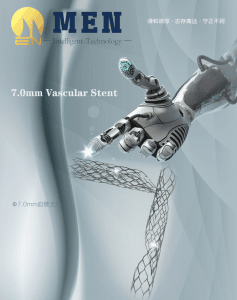Introduction of laser cutting technology for microvascular structure of vascular stent
(Click 919 )Vascular stent refers to the placement of internal stent in the diseased segment on the basis of balloon dilatation to support the vessels in the stenosis and occlusion segment, reduce the elastic retraction and reshaping of the vessels, and maintain the smooth blood flow in the lumen. Some internal stents can also prevent restenosis. It is mainly divided into coronary stents, cerebrovascular stents, renal artery stents, large artery stents, etc.

The cutting quality of the support mainly depends on the cutting dimensional accuracy and the quality of the cutting surface. The cutting surface quality includes: the width of the cut, the roughness of the cut surface, the width of the heat affected zone, the ripple of the cut section and the slag hanging on the cut section or lower surface There are many factors that affect the cutting quality of supports, and the main factors can be divided into three categories:
a. Characteristics of the processed object (material, shape, size, surface state, etc.);
b. The performance of the processing system itself (mechanical system accuracy, workbench vibration, etc.) and the influence of light (wavelength, output power, beam mode, beam shape, diameter, divergence angle, focal length, focus position, focal depth, spot diameter, etc.);
c. Processing parameters (material feed speed, accuracy, auxiliary gas parameters, nozzle shape and hole size, laser cutting path setting, etc.)
The specific extension of the laser cutting process for the microporous structure of the vascular scaffold has five characteristics:
1. Requirements of laser cutting for medical thin-walled pipes: the raw materials used for the fabrication of supports are generally medical thin-walled metal pipes, and seamless pipes are used to ensure the consistency and continuity of materials The metal material can be 316LVM medical stainless steel, cobalt chromium alloy or nickel titanium shape memory alloy As a kind of three kinds of medical devices, in addition to the uniformity of the chemical composition of the material, the size and shape requirements of the stent should also be considered, such as the diameter, wall thickness, dimensional deviation, straightness, cylindricity, coaxiality, etc
2. laser processing system: at present, nanosecond laser (such as nd ∶ YAG laser, water jet laser) and femtosecond laser are used for cutting metal vascular stents For micro devices such as vascular stents, the narrower the slit width is, the better. Therefore, in order to obtain high power density and fine incision, the smaller the focus spot diameter is required
3. Design of cutting path: Design of cutting path although nd ∶ YAG laser has high precision, the error caused by micro instruments such as brackets along the length of the processed pipe can not be ignored Due to the accumulated error, the change of the width of the support rod along the axial direction of the support will cause the support to lose its supporting effect. Therefore, the design of the cutting path of the support is very important. A good cutting path should be able to compensate for this error and minimize the thermal impact caused by cutting without reducing its mechanical performance. It is best not to reduce the cutting efficiency.
4. influence of air flow and nozzle during laser cutting: oxygen assisted melting cutting is adopted for bracket cutting, with oxygen purity of 99.95% and pressure of 0.3 ~ 0.6mpa In laser cutting, the gas flow can provide part of cutting energy.
5. selection of laser cutting speed cutting speed is another important factor affecting the cutting quality. The oxygen assisted laser cutting speed is related to the laser power density, oxygen flow rate and notch width. When the laser power density remains unchanged, the cutting speed increases with the increase of oxygen flow rate; However, at a certain optimal value, the cutting speed will not increase as the oxygen flow rate continues to increase. When the oxygen flow rate exceeds a certain limit, the cutting speed will start to decrease due to the cooling effect The higher the laser power density, the faster the cutting speed Under certain cutting conditions, there is a reasonable range of cutting speed. If the cutting speed is too high, the slag can not be removed from the incision, or even the cutting can not be penetrated; If the cutting speed is too low, the material will be overburned and the notch width and heat affected zone will be large Through orthogonal test, the most suitable cutting speed is 2.5 ~ 3.0mm/s.
 WhatsApp:
WhatsApp: Wechat
Wechat
Factors affecting the processing quality of laser cutting machine 2024-03-25
Laser cutting is a more common processing method in laser processing, and it is also a relatively simple one. The processing quality of the laser cutting machine is mainly reflected in the processing accuracy and surface quality, and the cutting surface quality is determined by …
Application of laser drilling machine in photovoltaic industry 2024-03-18
Laser drilling uses a high-energy-density laser beam to locally heat the material to a high enough temperature to evaporate, melt or vaporize it to form holes. The key to laser drilling lies in precise control of energy density, line speed and focus position to achieve precise p…
cutting machine manufacturers explain in detail the differences between ultraviolet, red light and green light sources? 2024-03-14
The most commonly used light sources for laser cutting machines are mainly red light, ultraviolet light, and green light. Each type of light source has different advantages. According to the characteristics, thickness and processing quality requirements of the processing materia…
Application and processing advantages of laser cutting machine in metal speaker mesh 2024-03-11
Metal speaker mesh is mainly used in sound-producing components of electronic equipment such as automobiles, mobile phones, and stereos. It is made of metal and has the characteristics of durability, good air permeability, etc. In the process of forming the metal speaker mesh, a…